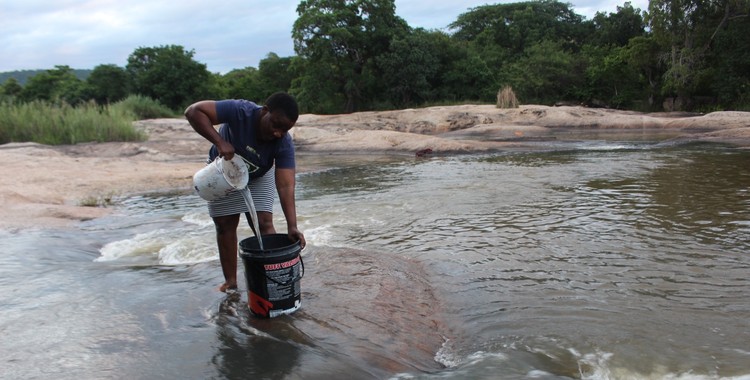
6 March 2024
Residents of KaMajika Village near Hazyview collect water from the Kambeni River. Photo: Masoka Dube
“The last time we saw a drop of water coming out of the tap was about 15 years ago. I remember this very well, because that was when my nephew was born,” says Mcebo Hlathi from Swalala Village in Mbombela Municipality in Mpumalanga.
Hlathi’s village is home to more than 8,000 people, according to Stats SA. While many of the villagers live in brick houses, the area is largely rural and has very little infrastructure.
Hlathi, who is unemployed, lives with five other relatives. They spend R300 a month to fill up a 5,000-litre water tank. Hlathi lost her job at the local supermarket two years ago and now relies on her two children’s social grants to survive.
To make the water they buy last longer, Hlathi’s family use a pit toilet instead of their their flush toilet. She says neighbours who can’t afford to buy water are forced to cart containers in wheelbarrows to and from the communal borehole about three kilometres away.
Last week, the South African Human Rights Commission (SAHRC) released a report, following an inquiry into how Mpumalanga municipalities serviced communities in the 2021/22 financial year.
The inquiry came after protests and complaints against various municipalities in Mpumalanga over the years. All 17 local and three district municipalities as well as relevant government departments made presentations.
Teenagers collect water from a communal borehole in Swalala Village, Mbombela in Mpumalanga. The taps in the area have been dry for 15 years. Photo supplied by villagers
Issues raised included the failure by municipalities to provide water and housing, sewage spillages, sewage treatment challenges, non-collection of refuse and potholes on the roads.
According to the report, the Mbombela Municipality noted that a 2016 community survey revealed that 149,599 households had access to water while 58,209 did not.
Municipal Manager, Wiseman James Khumalo, told the inquiry that the municipality had several challenges which included low revenue collection. Revenue was mainly collected in towns and urban areas, such as Mbombela, White River, Hazyview, Barberton, Kabokweni, KaNyamazane, and Matsulu. “The remaining 70% comprises rural areas who do not pay for services,” he said.
The SAHRC found during a site visit to Kashabalala Village that some residents had standpipes but rarely got water. In another section, families got water from their taps only once a week. On other days they had to go to communal standpipes. Some households had Jojo tanks. “Those residents buy water from private vendors for R150 per 2,500 litre tank,” the report stated.
The commission found that the municipality was in “violation of section 27 of the Constitution of the regulations relating to compulsory national standards and measures to conserve water”.
“The planning of the municipality is premised on old statistics dating back from 2016 which renders the planning ineffective as the population has grown significantly,” the report read.
The commission ordered the municipality to comply with national water provisions within 90 days of the report’s release. This includes providing a minimum of potable water of 25 litres per person per day or six kilolitres per household per month. It should be within 200 metres of a household; and “with an effectiveness that no resident is without for more than seven full days in any year”.
The City is also expected to submit a detailed report to the commission within 30 days of the report on its plans to address the growing issue of land occupations which affect the delivery of services in the municipality.
Municipal spokesperson Joseph Ngala acknowledged that some communities did not get water consistently. Ngala blamed the water problems in Swalala Village on an influx of people occupying land and making illegal connections to the water infrastructure there.
As a temporary solution, four boreholes had been installed and supplies to affected communities would be supplemented by water tankers, said Ngala.
On Shabalala Village, he said: “This area receives water at least once every third day. The reticulation infrastructure has been upgraded except at newly established areas on the eastern bank of the village. This area too will soon receive reticulation network and will be supplied through the Nyongane reservoir distribution zone.”
He acknowledged that Sand River Village and KaMajika area were experiencing a water crisis. “The main supply issue here is the insufficient storage available in the area. The area has grown over the years and the bulk water supply infrastructure has never been upgraded.”
He told GroundUp the municipality is requesting funding for the upgrading of the bulk infrastructure network, including water treatment works, reservoirs and pump lines.